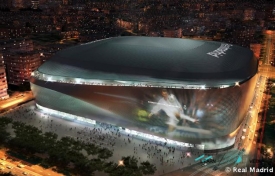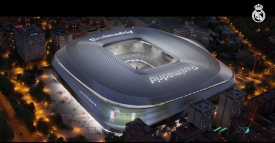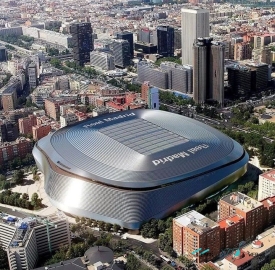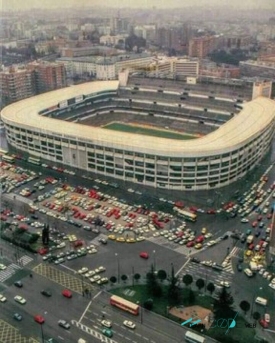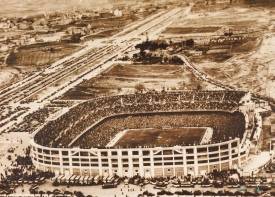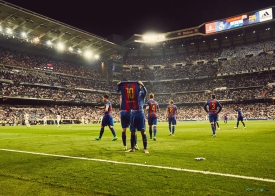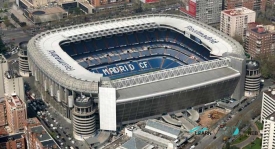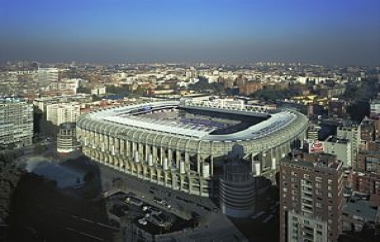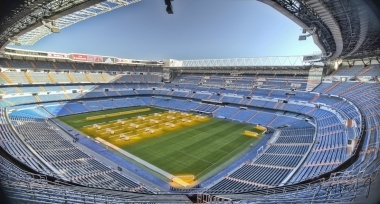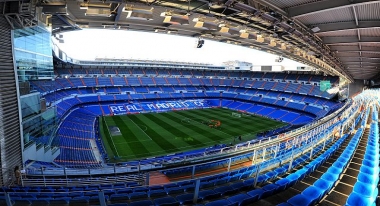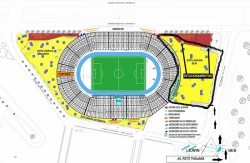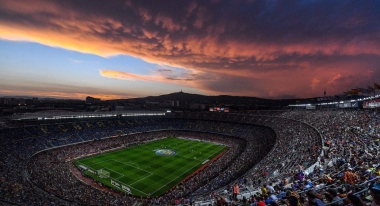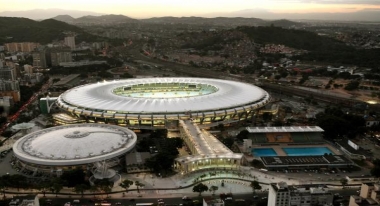ABOUT Santiago Bernabeu Stadium
The Santiago Bernabéu Stadium is a sports venue owned by the Real Madrid Football Club, located in the Paseo de la Castellana, in the Chamartín district of Madrid, Spain. It was inaugurated on December 14, 1947 and its capacity is currently 81,044 spectators. The stadium is listed by UEFA with the highest distinction, "elite stadium".
The stadium was inaugurated on December 14, 1947, with a friendly match between Real Madrid and Belenenses de Portugal, under the name "Estadio Real Madrid Club de Fútbol", although it continued to be known among fans as "New Chamartín Stadium". " or simply "Chamartín". The original venue had a capacity of 75,145 spectators.
Due to the high demand for tickets, the stadium became too small. For this reason, in 1953 the remodeling works of the enclosure began. On June 19, 1954, the first expansion of the stadium was inaugurated with the construction of a third amphitheater on the east side, adding a stand in the Padre Damián street area, popularly known as the "chicken coop", increasing its capacity to 125,000 spectators. Thus, the Madrid Coliseum became the second stadium with the largest capacity in Europe behind Wembley Stadium.
In the 80's, chosen as one of the venues for the 1982 World Cup, the stadium was remodeled again. As a result of profound changes required by FIFA, the capacity of the Bernabéu was reduced from 125,000 to 90,800 spectators.
At the beginning of the 1990s, the Santiago Bernabéu underwent a new expansion, increasing the total capacity of the stadium by 20,000 seats to accommodate 106,000 spectators.
In the new century the stadium continued to undergo changes in its structure. Florentino Perez presented a project for the coverage, expansion and restructuring of the stadium that seeks to increase the capacity by 8,000 seats, the restructuring of the stands, the complete lining of the stadium with a retractable cover and the integration of a hotel, a shopping center and underground parking.
On January 31, 2014, it was announced that the winning project was the one led by the German studio GMP Arquitectos, presenting the model and recreation of the stadium, once remodeled. Finally, on May 15, 2017, the plenary session of the Madrid City Council approved the special reform plan for the stadium, with an estimated cost of 400 million euros and whose works are scheduled to begin in June 2019, with the demolition of the center commercial La Esquina del Bernabéu and the demolition of the access towers of the Castellana.
The stadium will grow 12 meters in height for the construction of the integral roof. The retractable roof will open in 15 minutes and will have an impact to reduce noise on event days for neighbors and weather protection. The stadium will also feature a 360-degree scoreboard, as well as external lighting that can change color like the one at Munich's Allianz Arena. The museum will also be expanded and the urban environment will be modified with a new large central square on Paseo de la Castellana, Rafael Salgado street will be pedestrianized and a new square will be built on the corner of Padre Damián street. Finally, the capacity will be increased to 82,000 spectators, but no hotel or shopping center will be built. The total cost will be 525 million euros and the work will be carried out by the construction company FCC, whose completion is scheduled for December 2022, coinciding with the 75th anniversary of its construction.
The stadium was inaugurated on December 14, 1947, with a friendly match between Real Madrid and Belenenses de Portugal, under the name "Estadio Real Madrid Club de Fútbol", although it continued to be known among fans as "New Chamartín Stadium". " or simply "Chamartín". The original venue had a capacity of 75,145 spectators.
Due to the high demand for tickets, the stadium became too small. For this reason, in 1953 the remodeling works of the enclosure began. On June 19, 1954, the first expansion of the stadium was inaugurated with the construction of a third amphitheater on the east side, adding a stand in the Padre Damián street area, popularly known as the "chicken coop", increasing its capacity to 125,000 spectators. Thus, the Madrid Coliseum became the second stadium with the largest capacity in Europe behind Wembley Stadium.
In the 80's, chosen as one of the venues for the 1982 World Cup, the stadium was remodeled again. As a result of profound changes required by FIFA, the capacity of the Bernabéu was reduced from 125,000 to 90,800 spectators.
At the beginning of the 1990s, the Santiago Bernabéu underwent a new expansion, increasing the total capacity of the stadium by 20,000 seats to accommodate 106,000 spectators.
In the new century the stadium continued to undergo changes in its structure. Florentino Perez presented a project for the coverage, expansion and restructuring of the stadium that seeks to increase the capacity by 8,000 seats, the restructuring of the stands, the complete lining of the stadium with a retractable cover and the integration of a hotel, a shopping center and underground parking.
On January 31, 2014, it was announced that the winning project was the one led by the German studio GMP Arquitectos, presenting the model and recreation of the stadium, once remodeled. Finally, on May 15, 2017, the plenary session of the Madrid City Council approved the special reform plan for the stadium, with an estimated cost of 400 million euros and whose works are scheduled to begin in June 2019, with the demolition of the center commercial La Esquina del Bernabéu and the demolition of the access towers of the Castellana.
The stadium will grow 12 meters in height for the construction of the integral roof. The retractable roof will open in 15 minutes and will have an impact to reduce noise on event days for neighbors and weather protection. The stadium will also feature a 360-degree scoreboard, as well as external lighting that can change color like the one at Munich's Allianz Arena. The museum will also be expanded and the urban environment will be modified with a new large central square on Paseo de la Castellana, Rafael Salgado street will be pedestrianized and a new square will be built on the corner of Padre Damián street. Finally, the capacity will be increased to 82,000 spectators, but no hotel or shopping center will be built. The total cost will be 525 million euros and the work will be carried out by the construction company FCC, whose completion is scheduled for December 2022, coinciding with the 75th anniversary of its construction.



